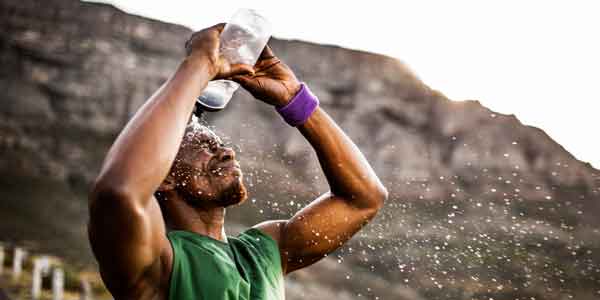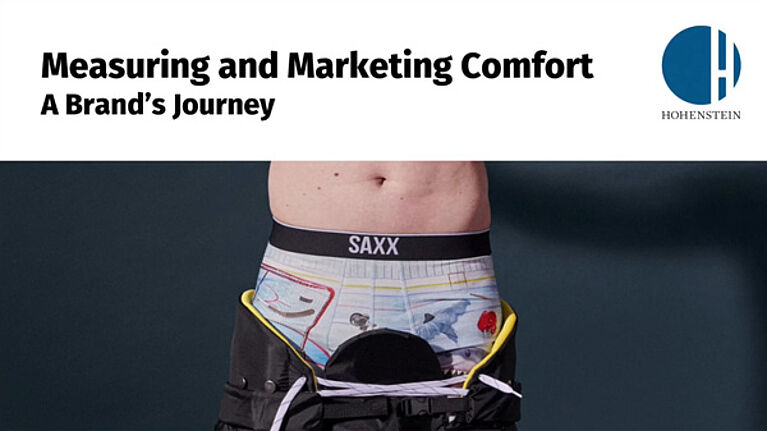Wearing Sensation on the Skin
We developed the skin-sensorial comfort assessment through applied research. The method turns subjective sensations into objective data.
Five main factors contribute to skin sensory comfort:

Comfort and functionality are important for clothing and home textiles. Textile materials and garment systems for many uses (e.g., everyday life, sports, workwear, personal protective equipment) must function, allow freedom of movement, support and enhance performance. The same applies to home and contract textiles. Comfortable bedding, for example, contributes to healthy sleep.
Basically, textile comfort is about heat regulation and moisture management, the sensation on the skin and ergonomic design.

We are pioneers in the development of scientific methods for objectively determining the wear and sleep comfort of textile products. Our expertise supports claim verification and product development:
We work with material developers, manufacturers and brands to optimize comfort by assessing specific characteristics of materials, apparel, sportswear, workwear, PPE, bedding, sleeping bags, car seats, furniture and more.
Our expertise is especially suited to creating testing plans around the end-user's needs. We conduct research, invent measurement methods and devices and correlate/verify the data.
We transfer this knowledge by writing standards and leading committees, as well as with the Hohenstein Academy.
We developed the skin-sensorial comfort assessment through applied research. The method turns subjective sensations into objective data.
Five main factors contribute to skin sensory comfort:
To what extent is comfort influenced by garment construction, fit and heat and moisture management?
Using our thermal manikins and climate chambers, we determine the heat and moisture management parameters of entire clothing and textile systems - in the expected ambient conditions - during the potential user's movements.
For example, in personal protective equipment (PPE), comfort plays a key role in safety and user acceptance. PPE must be tailored to the needs of the wearer - while working in emergency environments - and be comfortable during all motion sequences.
For sports and outdoor clothing, a three-layer clothing system is often recommended. Each layer fulfills a different function. Together, the layers optimize comfort for the specific use.
We test and classify the product performance of the individual clothing layers (DIN EN 16422). The tests characterize the thermoregulatory properties according to clothing layer and use case. Based on these results, we create a Hohenstein Performance Index for each product. The index allows users to compare individual materials/garments.
Through extensive research, we've developed or modified specialized equipment to reliably determine the physical parameters of heat and moisture management. To test for specific user scenarios, we use climate chambers to simulate use and climate conditions that are adjusted to the application.
To measure comfort (also known as skin sensory comfort) we employ methods developed from years of scientific research to objectively evaluate subjective sensitivity.
Clothing forms a barrier between the human skin and the external environment. Materials and garments should support a wearer's performance and comfort, not restrict the body's natural mechanisms for maintaining physiological comfort and movement.
These tests are especially suitable for assessing the comfort of sports/outdoor clothing and other garments:
Hohenstein develops smart testing programs based on your target users and goals.
Home textiles include bedding systems, mattresses, mattress covers, sheets, blankets, duvets, pillows, upholstered furniture, office chairs, towels, etc. Along with durability, safety and sustainability, comfort is a top priority.
These tests are especially suitable for assessing the comfort of home and contract textiles:
Hohenstein develops smart testing programs based on your target users and goals.
Medical textiles (such as surgical masks, surgical gowns, bandages, medical uniforms, etc.) are closely linked to other technical textiles. Comfort requirements depend on the application of the medical textile.
These tests are especially suitable for assessing the comfort of medical textiles:
Hohenstein develops smart testing programs based on your target users and goals.
Personal protective equipment (PPE) and military textiles include garments and face/body coverings, some of which are used in extreme conditions. The main task is to protect the wearer from external threats such as heat, flames, cold, electrical charges or moisture. These conditions place complex demands on textiles. In addition to their protective function, they must be durable and comfortable.
These tests are especially suitable for assessing the garments with protective functions:
Hohenstein develops smart testing programs based on your target users and goals.
Disposable and reusable hygiene products include wipes, sanitary towels, diapers and incontinence products, etc. Because hygiene products are used and worn close to the body, a good feeling on the skin and comfortable heat and moisture management are important.
These tests are especially suitable for assessing the hygiene products and materials:
Hohenstein develops smart testing programs based on your target users and goals.
